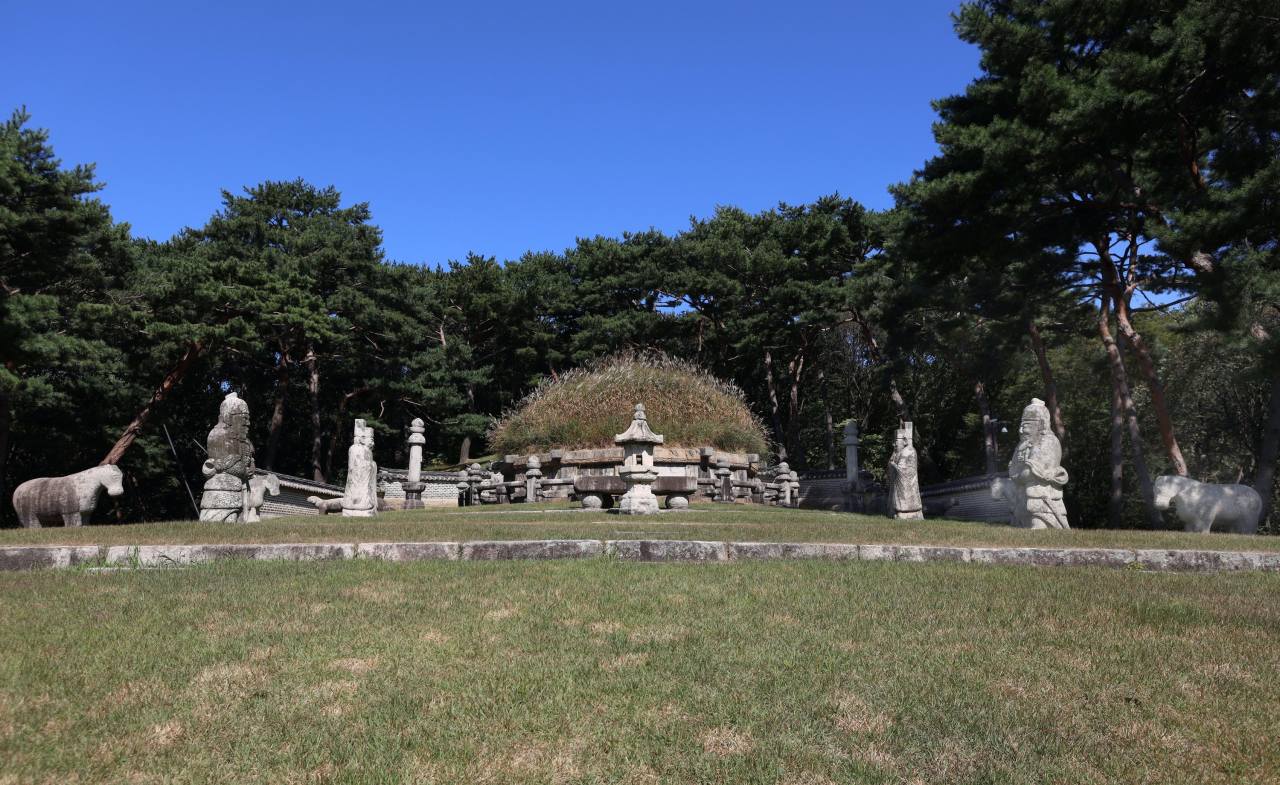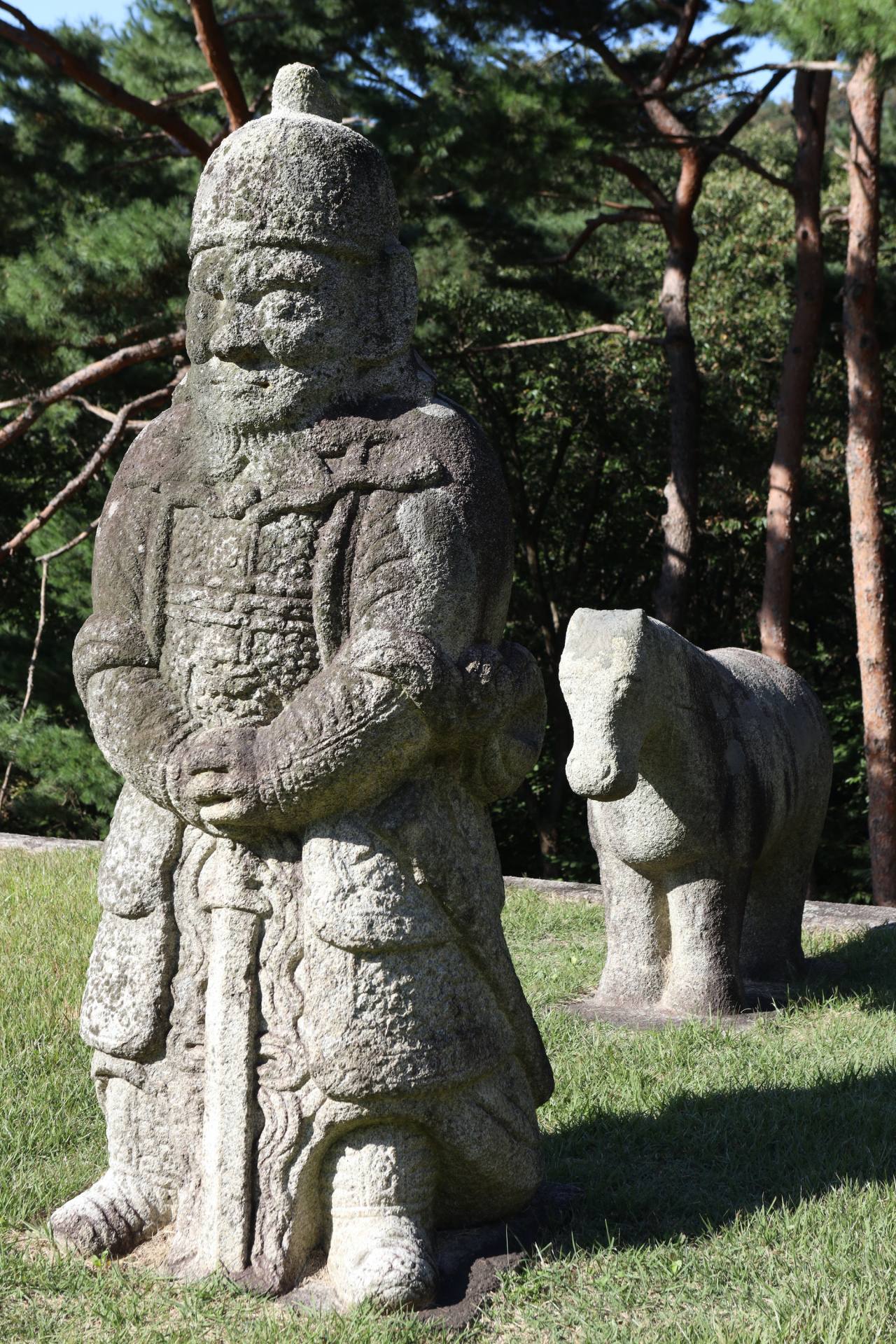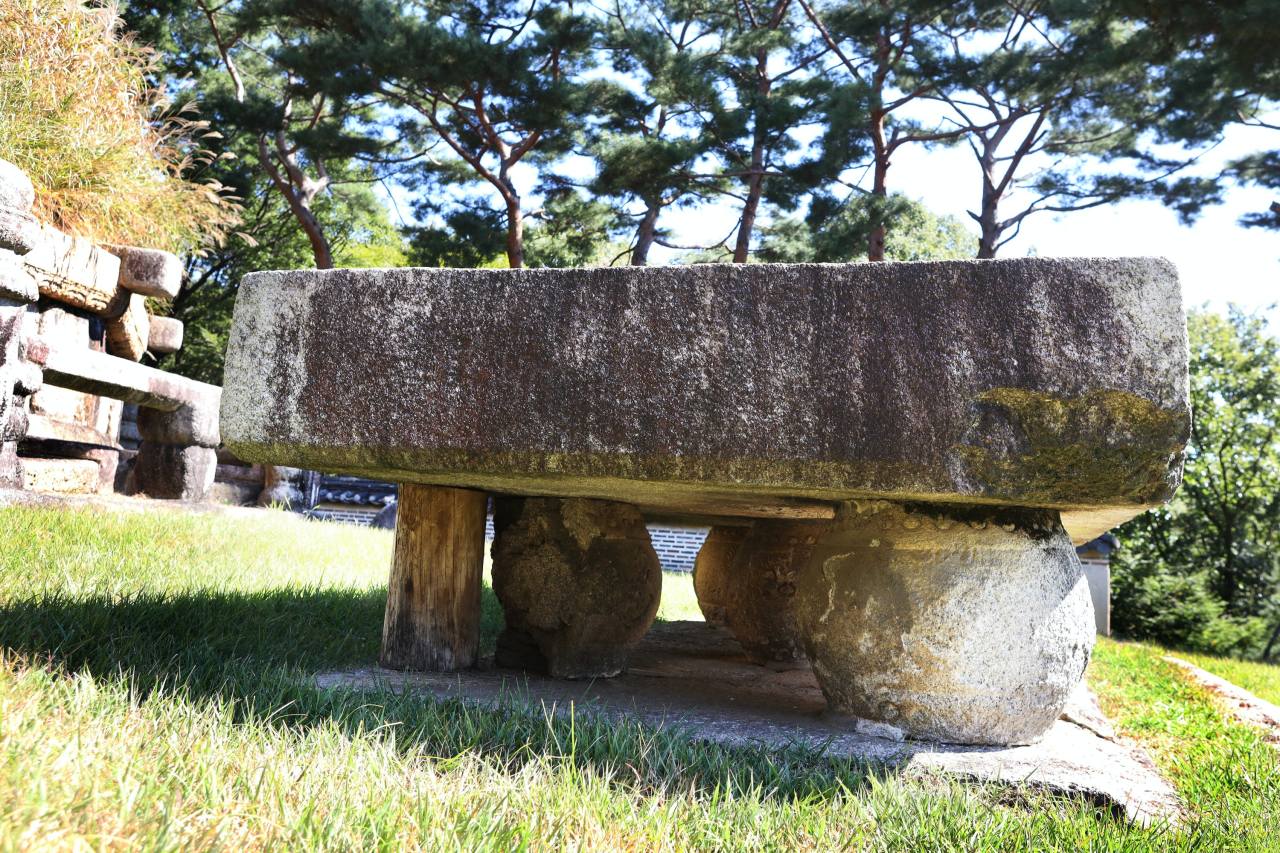
Silver grass grows on the royal burial grounds of the last king of the Goryeo Empire and Joseon founder Yi Seong-gye in Guri, Gyeonggi Province. Unlike other tombs with tall mounds that are mowed regularly, Yi’s tomb has silver grass growing on it. His fifth son, Bang-won, had the silver grass and soil from Hamheung planted on his father’s tomb. Photo © Hyungwon Kang
The Korean landscape has an abundant number of royal tombs dating back to Ancient Joseon from 2333 BC to the Joseon Kingdom of the 20th century.
While most of the royal tombs of previous kingdoms still remain unidentified, all of the royal tombs of the Joseon Kingdom from that of the founding father of Joseon Yi Seong-gye to the last Emperor Yunghui of the Korean Empire are clearly marked and maintained in pristine condition.
During the Joseon era, when the Yi family of Jeonju ruled Korea continuously for more than 500 years, Korea’s 5,000-year history of royal tomb architecture was reflected in the building and management of the royal tombs of Joseon kings and queens.
The royal tombs are located on the most prized land in terms of “pungsujiri,” the study of “land energy.” The areas surrounding the royal tombs are protected from new construction to maintain the pristine landscape.

A stone statue of a warrior with a horse guards the royal tombs of the last king of the Goryeo Empire and Joseon founder Yi Seong-gye in Guri, Gyeonggi Province. Photo © Hyungwon Kang
The burial tomb area must be surrounded by mountains that have a stream or river flowing out of the area nearby in order to meet pungsujiri requirements that say will help channel energy for the future generations of the royal family.
Only royal burial grounds are adorned with stone figures of warrior statues. There are also tigers, horses and goats, among other animal figures.
Ceremonial buildings where the incumbent king meets with the spirit of the ancestor are built on the grounds.
All of the Joseon royal burial grounds are classified into three categories: “Neung” where the kings and queens are buried; “won,” the tombs of crown princes and crown princesses; and “myo,” the tombs of fathers of kings, princes, princesses, concubines and other nobles.
The 40 royal tombs of the Joseon era have been designated UNESCO World Heritage sites.
Invaders throughout history almost always raided royal tombs to desecrate the tombs and loot treasures.
Gwanggaeto the Great (374-412) of Goguryeo, the 19th monarch of Goguryeo, whose immediate ancestors’ tombs were raided by the enemy during wars, left specific instructions that he had to have more than 300 grave keepers safeguard the royal tombs.
Korean rulers were buried with lots of treasures. For instance, when the tomb of Emperor Muryeong of Baekje (462-523), the 25th ruler of Baekje, was accidentally unearthed, more than 4,000 treasures were excavated.
During the early 20th century, ancient royal tombs were dug up by tomb raiders with the emergence of antique trading business fueled by the demand from the Japanese colonizers. In the 1930s, a Japanese settler bought up parcels of farmland and hills in Jangsu County, North Jeolla Province, where Gaya tombs were located and dug out artifacts from ancient Gaya tombs.

One of the legs supporting the altar at the tomb of Yi Seong-gye was blown off during the Korean War.Photo © Hyungwon Kang
Traditional Korean tombs had various stone burial chambers made with granite stones.
Some royal burial chambers used up to 50 or more metric tons of large stone tablets, an expensive and labor-intensive burial tradition.
During the Joseon period, large stone burial chambers were replaced with quicklime called “hoegyeok.” Once hardened, hoegyeok -- a mix of lime, fine sand and loess in the ratio of 3:1:1 mixed with water from boiled elm tree bark -- becomes stronger than modern-day concrete, making the burial chamber impenetrable.
Ernst Oppert (1832-1903) from Hamburg, Germany, the author of the book “Ein verschlossenes land: Reisen nach Corea,” learned not to mess with Korean royal tombs in 1867.
Oppert, a failed businessman in the Qing dynasty, borrowed funds to lead several expeditions to Korea to open the closed door policy, all without success.
The only country in the world where its people imported Christianity of their own volition, Koreans requested Catholic missionaries to visit the Joseon Kingdom. When three French missionaries were executed along with thousands of Korean Catholics, some Korean Catholics fled to Qing China where they advised Oppert about Joseon.
Oppert led an expedition to Korea to raid the grave of Prince Namyeon, the father of Heungseon Daewongun, who was the de facto ruler of Joseon at the time, and to force him to end the closed door policy.
After five hours of digging, Oppert’s crew could not break open the burial chamber of the tomb.
Heungseon Daewongun (1820-1898) was not amused. He continued the closed door policy against all Western countries and more Catholics were killed.
Today the royal tombs of Joseon dating from 1408 to 1966 are managed by the Cultural Heritage Administration with a 1.2 trillion won ($893 million) budget, of which approximately 53.6 billion won is spent annually on the royal tombs of the Joseon era, according to Chung Jae-suk, a former CHA head.
The last royal tomb burial was that of Empress Sunjeonghyo (1894-1966), the second queen to the last emperor of the Korean Empire, on Feb. 13, 1966.
Empress Sunjeonghyo was buried with her favorite toaster and a coffee pot next to her late husband, Joseon King Sunjong (1874-1926), and Emperor Yunghui of the Korean Empire along with Sunjong’s first wife, Empress Sunmyeonghyo (1872-1904), at the Yureung Royal Tombs in Namyangju, Gyeonggi Province
By Hyungwon Kang (hyungwonkang@gmail.com)
---
Korean American photojournalist and columnist Hyungwon Kang is currently documenting Korean history and culture in images and words for future generations. -- Ed.




![[Herald Interview] 'Amid aging population, Korea to invite more young professionals from overseas'](http://res.heraldm.com/phpwas/restmb_idxmake.php?idx=645&simg=/content/image/2024/04/24/20240424050844_0.jpg&u=20240424200058)



